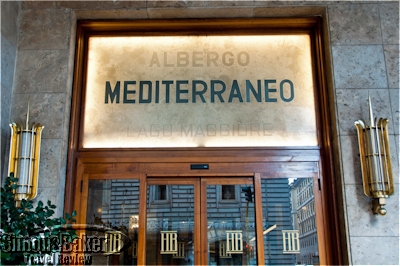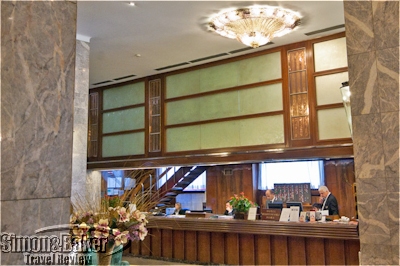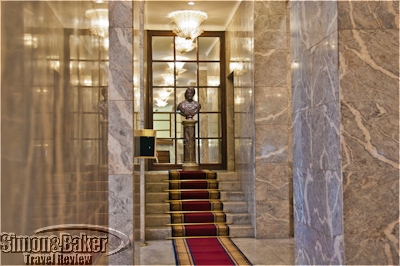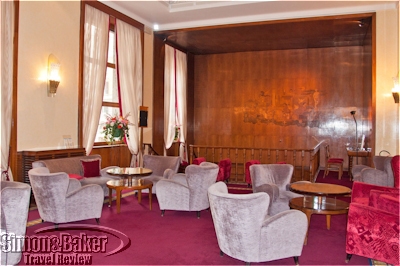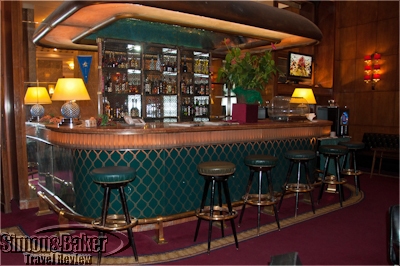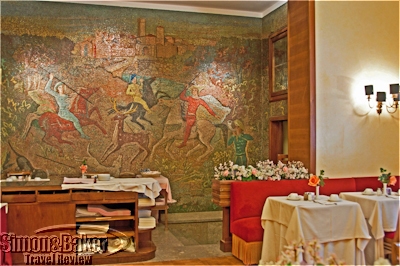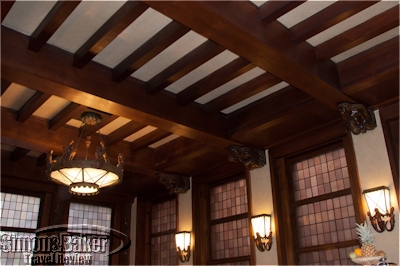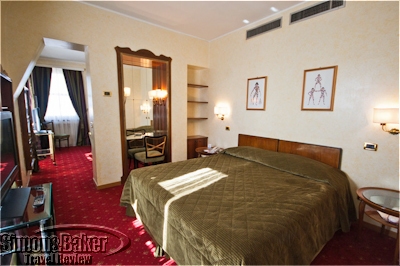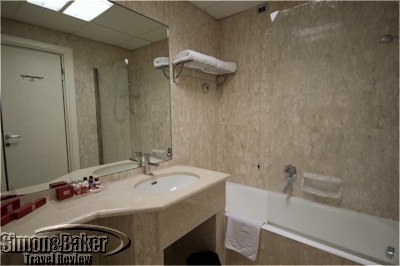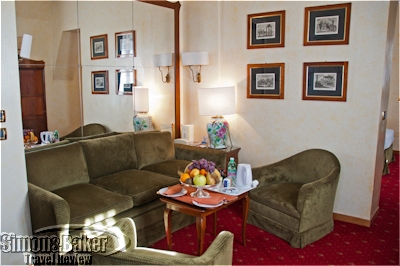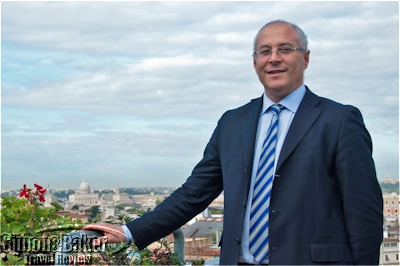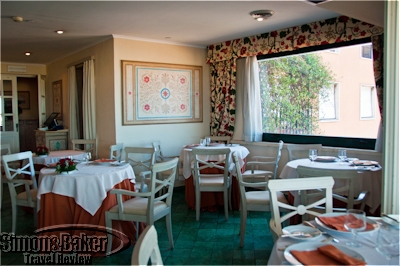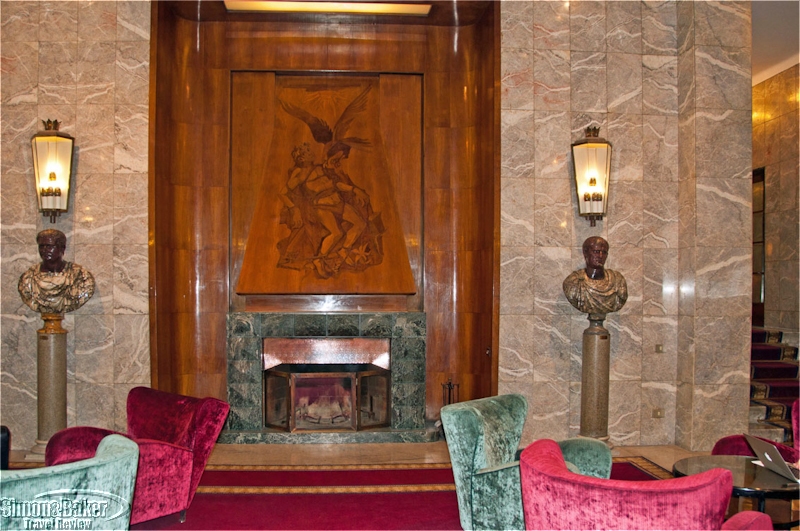
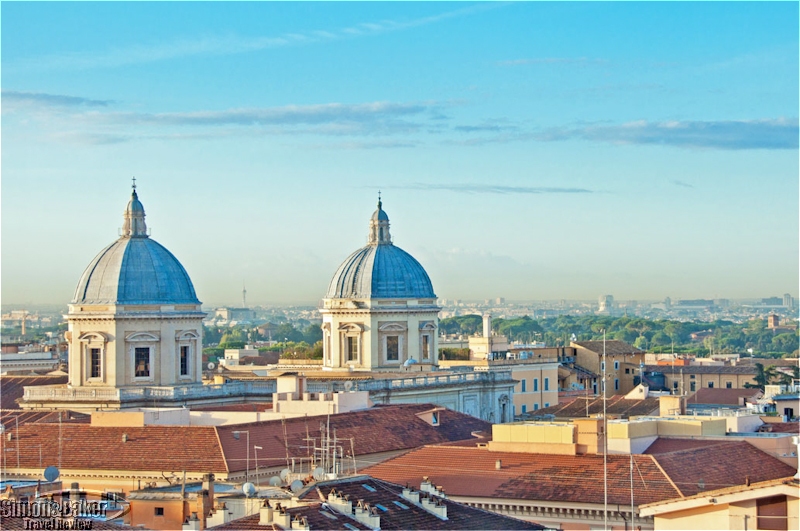
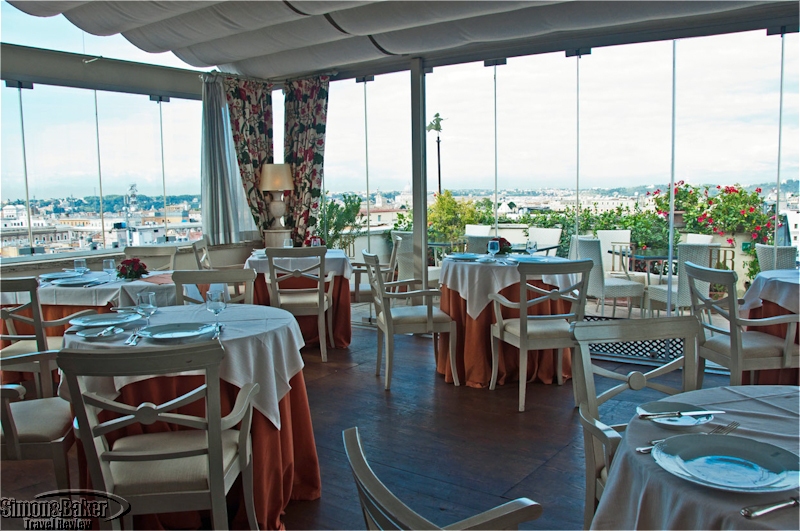
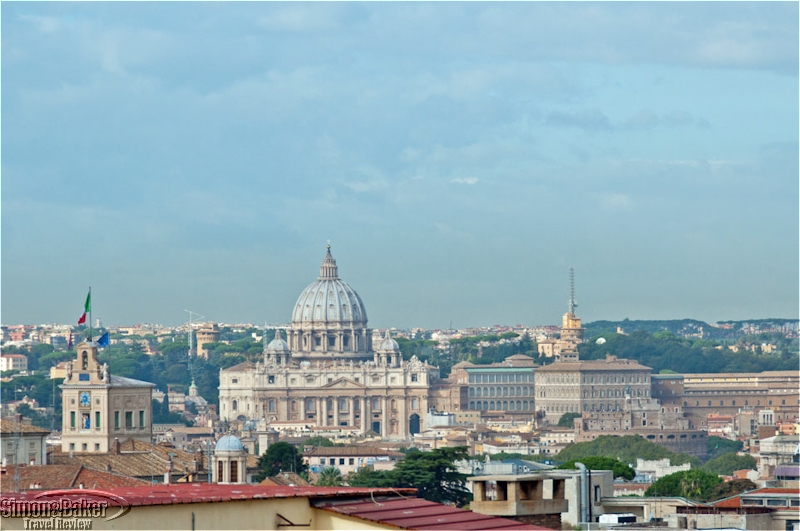
Designed in 1936 by Mario Loreti, a foremost Italian architect of the era, and completed in 1942, it is considered one of the finest examples of Art Deco architecture and rationalist design in Rome. From the moment I entered the lobby with its exotic woods paneling and soaring polished marble columns flanked by busts of Roman emperors, I felt transported into a glamorous 1930s movie set. I would not have been overly surprised to see Fred Astaire materialize at the top of the imposing marble staircase. The Mediterraneo maintained its Art Deco persona throughout its monumental public areas. In the lounge, a parchment map of an ancient perspective of the Mediterranean Sea occupied an entire wall, while the opposite one was covered with an intricate marquetry mural of an allegorical scene. In the dining room, an exquisite wall-size tapestry-like mosaic evoked a medieval hunt. However, the most unique feature of the property was the Roof Garden Restaurant and Terrace. Built high on the Esquiline Hill, the highest of Rome’s seven hills, the ten-story, 50 meter (165 foot) high Mediterraneo was the tallest building in the center of the city. Its spectacular view swept across the rooftops, from the twin domes of nearby Santa Maria Maggiore all the way across town to San Pietro in Vaticano (San Peter). It was my favorite spot to linger, especially at dusk when far above the bustle of the city, I could sip a Spritz (local cocktail made of dry white wine, sparking water and bitter Aperol) while watching the sun set over the Vatican.
In pleasing contrast with the majestic and somewhat austere public spaces characteristic of the Art Deco style, my suite was a cozy urban retreat I looked forward to return to after a day of roaming around the city. While the original elaborate woodworks, built-in furniture and sober décor had been meticulously preserved, the suite had modern amenities, including double glazed windows and electric shutters, individually controlled air-conditioning, large widescreen television and contemporary marble-clad bathroom.
I liked the location of the Hotel Mediterraneo, in a lived-in neighborhood with easy access to the major touristic sites of the city, and its distinctive old world atmosphere. And best of all, I enjoyed the elegance and comfort of my light-filled suite, a relaxing home away from home that I will keep in mind for future visits to Rome.
Class Of Accommodation Four star hotel
Concierge Eugenio Bungaro
Connectivity There was complimentary WiFi in my suite and throughout the common areas. Connectivity was reliable in the common areas but erratic in my suite.
Handicapped Access Yes
Hotel Manager Claudio Garbo
Length Of Stay Three nights
Location Conveniently located in the center of Rome, the Mediteranneo was within reasonable walking distance from most of the popular monuments in the city. It was also a five-minute walk to the Termini central train station, bus terminal and subway, making it especially easy to get around via public transportation. For air travelers, the train shuttle between the Leonardo da Vinci/Fiumicino airport and the center of the city was also a few steps from the hotel.
Owned / managed Bettoja Hotels, one of the oldest and largest family-owned hotel groups in Italy for five generations. Chairman was Angelo Bettoja.
Pets Allowed Yes
Size The ten-story property had 251 rooms including seven executive suites and five junior suites. It employed a staff of 60.
Year Opened-Renovated Following a four-year construction effort, the property opened in 1942. It was the object of on-going meticulous renovations and upkeep to preserve its original Art Deco character.
Room Located on the ninth floor of the ten-story property, and graced with a southwestern orientation, my sun-filled 34 square meter (365 square foot) junior suite, Number 916, had an exceptional view of the city. The suite consisted of three cozy rooms laid out in enfilade, starting with the corner sitting room. The bedroom was in the center, followed by the dressing room and bath. There were burgundy carpeting and cream-glazed walls throughout. All upholstered pieces as well as the king size bed skirt and quilted coverlet were olive green textured velvet. The four tall windows had heavy floor-to-ceiling taffeta draperies in broad aubergine, olive and mauve stripes, trimmed with green fringe that matched the tasseled tieback ropes. Brass sconces with silk shades provided the lighting. In the sitting room, a Parsons-style sofa stood in a shallow mirrored alcove, with two matching barrel armchairs, a rectangular mahogany coffee table and a side table holding a flowered china lamp completing the sitting arrangement.
The most notable features of the room were the original built-in writing desk, bookcases and drawers fitted between the windows of the exterior walls. A grouping of framed etchings of ancient Roman monuments hung on the wall. In both the sitting room and bedroom, a large widescreen television sat on a metal and glass credenza in front of the window. In addition to the king size bed flanked by two round wood and glass side tables, bedroom furniture included a dressing table and chair in a mirrored alcove, recessed shelving above a built-in cabinet that concealed a mini-bar, and on the exterior wall, on both sides of the window, built-in storage drawers and shelves that matched those in the sitting room. A set of framed contemporary prints of harlequins added a whimsical touch. Other than the addition of a contemporary suite hanger and trouser press, the dressing room had fully retained its Art Deco personality with a kidney-shaped mirrored-top brass dressing table skirted in jade silk, black lacquered and brass chair and free-form wall hung mirror. The entire back wall was a paneled mahogany armoire made to accommodate the traveling wardrobe of a bygone era.
Also on the ground floor were the Lobby Bar and Ristorante 21, a small formal restaurant that served gourmet Italian cuisine for lunch and dinner. Its back wall was covered with a stunning mosaic fresco of a hunting scene. My personal favorite spot for cocktails and dinner was the lovely Roof Garden Restaurant and Bar and its glorious terrace with a panoramic view of the city. Day or night, the glassed-in dining room with its flowered chintz drapes, white painted armchairs and tables clad in cinnabar floor-length cloths with white linen overlays felt like a romantic sky-high garden room. The menu was a mix of Roman and international dishes. I especially enjoyed the bresaola appetizer, a carpaccio of aged air-dried beef served on a bed of peppery arugula with a balsamic reduction, a portion so generous that it could have been a light entrée. The fresh pasta with garlicky sautéed shrimp and zucchini that followed was equally delicious. In brief, everything that my friend and I sampled there was beautifully prepared from the freshest ingredients and made for a pleasing dining experience. In addition to hotel guests, the Roof Garden welcomed local diners for lunch and dinner. It was a popular place where reservations were strongly recommended.
Facilities There were three restaurants, a bar, a basic business center and a fitness room.
Fitness Center And Spa There was a small fitness center with basic exercise equipment.
Date Of Review October 2012
Reviewers Article and photographs by Josette King
Service The room was serviced daily. Every member of the staff I encountered during my stay was professional and efficient.
Would You Stay There Again? Yes
Contact Information
- Via Cavour, 15
- 00184 Rome
- Italy
- +39 06 488 4051
- +39 06 474 4105
